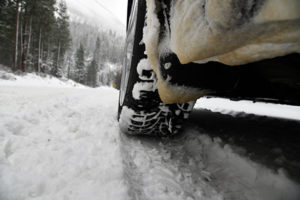Home »

Winter tires still needed to keep Kootenay motorists safe
How much longer should you use winter tires on your vehicle?
It’s a timely question for Kootenay drivers as spring approaches. The annual Shift into Winter campaign points out the answer is based on safety, not seasons.
 “Winter tires provide better traction and stopping performance below 7C and on wet, snowy, and icy roads,” said Louise Yako, spokesperson for the 13th annual winter driving safety campaign. “Traction may be the difference between safely driving on roads and being involved in a serious crash.”
“Winter tires provide better traction and stopping performance below 7C and on wet, snowy, and icy roads,” said Louise Yako, spokesperson for the 13th annual winter driving safety campaign. “Traction may be the difference between safely driving on roads and being involved in a serious crash.”
Winter tires or chains are required on most routes in B.C. from October 1 to April 30. For select highways not located through mountain passes and/or high snowfall areas, tire and chain requirements end March 31.
Regulated highways are marked with signs and the B.C. government provides a province-wide map of highways designated for winter tires. Information is also listed on DriveBC.ca.
Some B.C. roads don’t require winter tires. For those ones, drivers are encouraged to choose their tires based on the region and conditions in which they regularly drive.
Rain, slush, snow, or ice can make stopping your vehicle challenging as your tires have less traction on cold and slippery road surfaces. “For example, if you’re driving on a set of all-season M + S (Mud + Snow) tires on a rain-covered road at 80 km/h, you’ll need twice the distance to stop than you would when driving at 50 km/h.” Yako explained. “You need even longer stopping distances for snow- and ice-covered roads.”
Shift into Winter offers the following tips to help drivers stay safe at this time of year:
- Know before you go. Before leaving, check DriveBC.cafor updated road and weather conditions.
- Avoid driving when road and weather conditions are poor, if possible. If you have to drive when the weather is poor, make sure you and your vehicle are well prepared.
- Use four matched winter tires with the three-peaked mountain/snowflake logo. Keep a winter driving emergency kit in your vehicle.
- Prepare yourself by knowing how to drive for the conditions before you get behind the wheel. • Even the most experienced drivers can’t predict how their or the other drivers’ vehicle will react in snow or on ice.
- Follow safe work procedures if you drive for work, even if it’s only occasionally, and report any unsafe conditions to your supervisor.
- Make sure, if you’re an employer with commercial vehicles, that drivers know when to carry chains and how to use them.
“Every day thousands of British Columbians drive to, or for, work. Springtime in B.C. is unpredictable at best — often bringing snow, rain and slippery conditions. The extra traction provided by winter tires will reduce the risks to drivers in these changing weather conditions. Workers and employers must be aware of the various tire requirements on highways throughout B.C., so we can all get home safely at the end of the workday,” said Al Johnson, Head of Prevention Services at WorkSafeBC.
For more information visit ShiftIntoWinter.ca. The campaign is a joint provincial initiative supported by the Winter Driving Safety Alliance and managed by Road Safety at Work.
The Winter Driving Safety Alliance is a cross-section of 22 public, private, and non-profit organizations committed to working together to improve safe winter driving behaviours and practices in B.C. Members are: Ambulance Paramedics of BC; Automotive Retailers Association; BCAA; BC Forest Safety Council; BC Road Builders & Heavy Construction Association; BC Trucking Association; City of Kelowna; Concrete BC; CoreCode Safety and Compliance; Government of BC; Insurance Corporation of BC; Island Equipment Owners Association; Justice Institute of British Columbia; Kal Tire; Mainroad; BC Highway Patrol; Road Safety at Work; SafetyDriven; Tiger Calcium; Tire and Rubber Association of Canada; Wilson M Beck Insurance Group; and WorkSafeBC.
e-KNOW file photos
Road Safety at Work







